39 Brunswick Street West
If you, like me, enjoy roaming off the beaten track, you will find No 39 on the east side of Brunswick Street West in a row of both business and private premises. It differs from its neighbours with its tall frontage and mock Georgian bow windows on the ground floor and it clearly is a private home nowadays. Not many small buildings have seen so many diverse changes of use in less than two hundred years and if it could speak it would have many stories to tell, I am sure. I will endeavour to recount some of these.
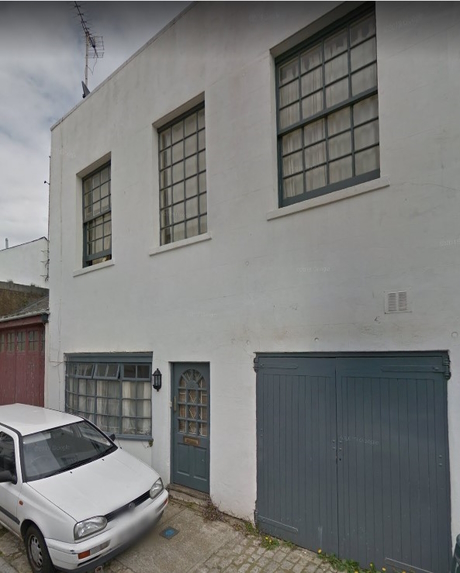
39 Brunswick Street West in 2017 from Google Streetview
The Building
Our house, No 39 was No 44 until around 1924/ 25 as it started life as the stable belonging to the grand house of No 44 Brunswick Square. The original intention of Charles Busby the architect, for the east side of Brunswick Street West, was to offer the stabling facilities to the affluent occupants of the West side of Brunswick Square. But I am told there was a choice in this and some owners left the space vacant, others created gardens and several stuck to the plan of building a stable.
There are adverts in the Brighton Newspapers for the sale or lease of the whole property including the stables in 1863, 1876 and 1893. In 1863 the stable was described as two stalls and a loose box that was convertible to two further stalls with a coach house large enough for three carriages and a harness room with a loft above. The 1876 advert mentioned four stalls and included a harness room with two living rooms above and by 1893 the coach house is described as just double. The 1876 advert mentions communication between the stables and the mansion suggesting that it was connected, rather than separate, to the main house.
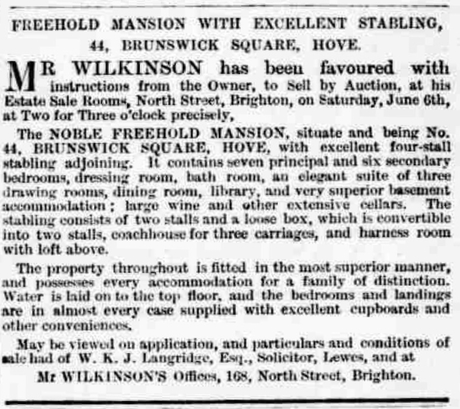
Brighton Gazette 28 May 1863 - sale of 44 Brunswick Square
To give you some idea of the internal size of this humble building using a fairly recent planning application, I would estimate a total floor area of over 2000 square feet divided equally between the two floors This is quite substantial when compared to that of a modern two-bedroom flat averaging at 800 sq ft. Unfortunately, the modern plan now shows a large upstairs flat belonging to 44 Brunswick Square leaving only 344 sq ft to No 39 on the first floor but I speculate that this is a recent alteration.
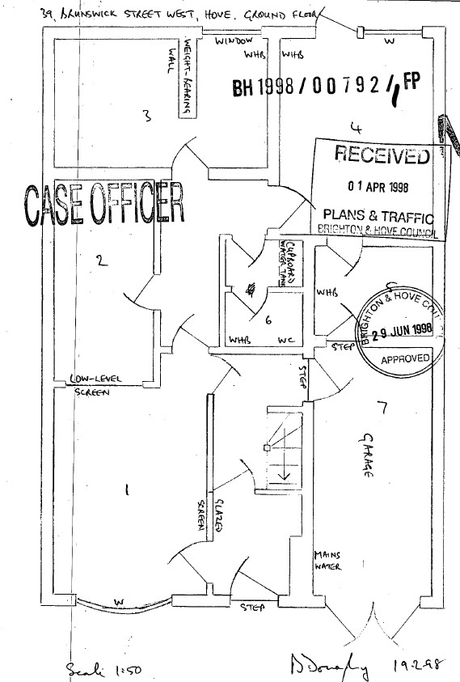
Ground floor plans in 1998
Many of the Planning applications for changes of use have so far been found to be either destroyed or elusive and so we can only conclude that the stable living quarters were surprisingly quite spacious.
The People
Our first mention of stable staff was while William Colegrave Esquire, born 1788 in Essex, lived in the main house from 1851 to 1855 with his wife Catherine Colegrave, born 1791 in Surrey, who was defined as a Lady in the Census of 1851. For a retired couple they must have led busy lives as they employed seven servants including a Butler and Footman. Of more interest to us in the 1851 Census for 44 Brunswick Square is a Henry Prediger employed as their Coachman with mention of his wife Mary Prediger who seems not to be in work. A William Wayden is listed in the same Census of the main house, as the Stableman not Stableboy perhaps because he was then aged 25.
By 1856, the Colegraves had moved and by the 1861 Census were living at 15 Brunswick Terrace taking with them only one servant, Jane Webber, and not the stable employees. Although there is no mention of other Colegrave family members at the main house in the Square, there is evidence of other Colegraves in the neighbourhood which would account for a full social life and need for so many servants and stable staff.
In the 1861 Census there is no mention of the 44 Brunswick Street West stables in spite of there being 19 and then 29 buildings being listed in this Street. It can only be assumed that there were no stable hands attached to the main house at that time or they were just left unregistered at either address.
More about Henry Prediger
One claim to fame is that he and his wife were counted twice in the Census of 1851. He was born in Bristol in 1801 and was 50 by the time he became Coachman to the Colegraves. He married Mary Cott, born 1807 in New Romney, in 1840 at a seemingly smart sounding locality, St Georges District, Hanover Square, Westminster. The 1851 Census also records him at Chapel Mews, a Livery Stable on Waterloo Street very close to Brunswick Square. He was employed there as Head Coachman and living with his wife Mary and a servant Lethe Welling aged 12. It was likely a ‘word of mouth’ recommendation that gained him the post with the Colegraves. We will never know if the Predigers lived in the main house leaving the stables for William Wayden or that they all shared that accommodation.
Henry, it seems, was only with the Colegraves for a few years. One possibility is that the Langridges, the next 44 Brunswick Square residents who obviously had need of but have no stable employees recorded, may have recruited Henry and the stableman William for a while.
Records between 1857 and 1871 find the Predigers at 17 Upper Market Street and according to Kelly's Directory they were running a boarding house. Mary was by then working as a laundress which has been amusingly, but erroneously, transcribed as shoemaker. Here there was first mention of a daughter Mary Harriet Prediger born in 1851 while they were still with the Colegraves but had not been recorded there. By the 1871 Census Henry was 70 and had obviously settled well into Brighton life but by the 1881 Census his wife was a widow and living with her daughter Mary Harriet at 28 Brooker St. Henry died at the age of 79 having lived a considerably long life for those days. It is unfortunate that I have so far found little history of Henry prior to his arriving in Hove.
There is also little known of William Wayden the stableman during this time, apart from he was born in Hertfordshire in 1826 and was unmarried. As already mentioned, when the Colegraves left the Square hopefully he was recruited by the Langridges or he found work locally in one of the many stables existing at that time. He died In Brighton at the early age of 37 in 1863.
The incoming family in the main house between 1856 and 1861 were the Langridges. William Vidler Langridge was Clerk of Peace for Sussex. With a wife Isabella Langridge and a daughter Isabella Sophia Langridge , aged 21 still living at home and an entourage of servants, you would expect he had a need for transport. and it can only be assumed the stable staff were just not recorded in the 1861 Census at either address or that he hired his transport from another source. The latter seems unlikely with his busy professional and consequent social life. How negligent of a Clerk of the Peace to not record his staff it seems! The wedding of another daughter Julia Langridge to William Hampton Carlisle at Hove Parish Church in October 1860 would surely have necessitated numerous carriages.

Brighton Gazette 11 October 1860
In the Brighton Gazette, January 1860 Mr & Mrs & Misses (x2) Langridge were mentioned as attending the large Military Ball at the Pavilion and in the same Newspaper as giving an Evening Party at 44 Brunswick Square. They were prominent socialites.
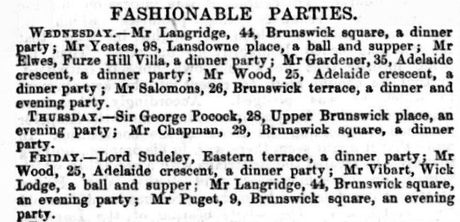
Brighton Guardian January 1860 - Fashionable parties on Wednesday and Friday!
For 30 years 1861 - 1891 the lack of evidence of stable employees attached to 44 Brunswick Square continued. The Census of 1891 mentions No 44 Brunswick Street West with no occupants but it also records the residents of a 44A as John Morgan, aged 26, a Coachman Domestic, his wife Francis Joanna Morgan née Manly aged 24 with a son Frederick J Morgan aged 9 months. The wedding and birth had been in Brighton that same year. I speculate that Number 44A was likely to be the upper floor of No 44 Brunswick Street West.
We move on finally to our last family in Brunswick Square with recorded stable employees, the Maules, and one of the stable people Edward Oxtoby. Edward with his small family has a more comprehensive, typical and interesting history. He was born in Skirlaugh in the East Riding of Yorkshire in 1871 and like many stablehands was from a farming background – his father was employed as a shepherd. He was still at home as a 10 year old scholar in the 1881 Census but by 1891, at the age of 20, was working for Lt Col George Edward Maule, a retired Royal Artillery Officer, at Woodlands, Mount Harry Rd, Sevenoaks as a ‘groom domestic servant’. He remained on the electoral roll there from 1893 to 1899. It is gratifying to know that his employers diligently registered his vote from their own property. Out of all the seven servants he was the only staff member to move to Brighton when the Maules moved to 44 Brunswick Square in 1899. He was obviously highly respected. In that same year, at the age of 28, Edward had married Alice Jane Brunger Homewood, aged 25 in Pluckley Kent and the certificate mentions he was then already in Hove working as a Coachman and her father was mentioned as a labourer. In 1901 they had a daughter Hettie Alice Oxtoby who seems to have been born at Pluckley. How and where the couple met remains a mystery as does where Edward started his working life. The 1901 Census describes him now as Occasional Coachman and in the 1911 Census as Coachman domestic so he has been promoted from being the groom and is registered separately to the Maules as at 44 Brunswick Street West. Surely a small recognition of status and independence! He features in the electoral rolls of 1902 and 1903 at the stable, 44 Brunswick Square.
There is no mention of any employment for his wife Alice but as Edward seems to have been working alone, she probably had to support him with his duties. With their own social calendar Lt Col Maule, his wife Emily Louise Maule and two single daughters in residence, Moonah Constance Maule aged 19 and Florence Emily Maule aged 21 at the time of the 1901 Census , the Maules must have provided a heavy workload for the stable.
Edward and Alice's daughter Hettie Oxtoby, aged 10, in the 1911 Census shows her as a scholar. With past family records mentioning an Anglican upbringing, it is likely that she attended St Andrew’s in George Street, a C of E Aided Primary School built in 1858. It was only an eight-minute walk away from her home and an obvious choice but of course parental preference wasn’t on the agenda in those days.
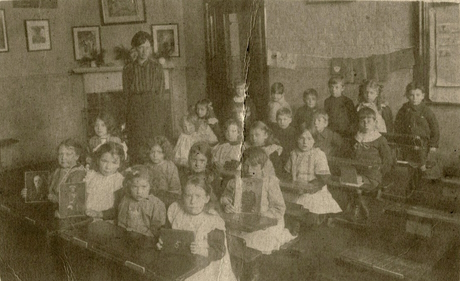
Children at St Andrew’s Church School 1916
We can guess she would have to wake very early to help her father in the stable and likewise after school. No doubt she would not have had a peaceful night's sleep with noise and smells coming from the horses in the stable below. Initially, I had thoughts of her playing with friends in the Street but considering those chores, the dangerous traffic in the area and the presence of dung pits along the street perhaps I was dreaming. I do hope though that she was able to venture down to the beach with her peers. There were some children of the Rossbrooks at No 47 with one girl Florence May the same age as Hettie and the Hydes at No 56 to play with. Did they go to Sunday School or participate in the Temperance Marches in the locality at that time. I can only speculate.
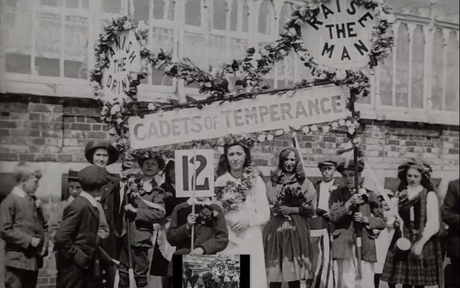
A 1913 temperance march along Brighton seafront
I have found no evidence, in spite of the proximity of several hostelries to No 39/44, that our stable occupants frequented these. A pity there were no registers taken and only mention of names in Newspapers when the ale drinkers misbehaved. I would be naive to believe that occasional visits by our No 44 stable workers would not occur after all the hard physical work the stable men had to endure. As evidenced by the emerging Temperance movement there was apparently a call for this organisation. But I am absolutely sure that the stable kids would be banned from the Brunswick Square Gardens!
Click here for a video of a local temperance march in 1913.
We now lose track of the Oxtobys until 1918 when just Edward and Alice are recorded as living at ‘Millbrook Cottage,’ Manor Rd in Chigwell, Essex. Edward at 47 would have probably been too old to be recruited in the First World War. Chigwell is on the outskirts of Epping Forest where numerous stables still exist and where someone, talented and experienced in all things equestrian, would find work. Our Edward died aged 47 in 1918 at the London Hospital and is buried at St Mary the Virgin, an Anglican Church in Chigwell. Probate shows he left £61 7s 3d which in 2023 equates to £2800.
The time frame for my research is almost at an end but it would be remiss not to mention briefly a few other occupants of 44/ 39 Brunswick Street West:
After the Oxtobys, Thomas Ezard 1913 -17, Henry J Bate 1918, Edith Fletcher 1919 - 23 , a Mrs Smith 1925, in 1926 E J Sercombe later described as a Chauffeur Mechanic in 1939 at another address, from 1931 - 32 and a Mrs Bridger who is possibly wrongly recorded.
Quite puzzling is Thomas Ezard, then 69 years, who is recorded at the Stable for No 52 Brunswick Square in 1911 living with his wife Elizabeth Ezard, 63 years of age. He is described as an ‘odd man no trade’ but at that same address in 1901 had been a stableman. They are Yorkshire folk and possibly were close to the Oxtoby’s, Edward being also from the East Riding. By 1913 the Oxtoby’s had left No 44 and Thomas Ezard had moved there. Thomas and Elizabeth stayed at ‘our’ stable until at least 1917 and they are further traced to 34 Cowper St from 1923 until 1928 when they would have been well into their eighties and no doubt retired. It is mysterious as to the reason they moved to our No 39 and it seems with no livelihood. Did squatting go on in those days?
As the era of the motor car and railways evolved it must have been a worrying time for stable employees and many, young enough, began to pursue training as chauffeurs or mechanics
I am now outside of the research time frame but I consider it important to mention these briefly in order to give a complete flavour of No 39’s use up until the present date. It became in 1960 Auto Discoveries, a MotorAgents; then in 1964 - 72/73 Lansdowne Cars (Sussex) Ltd, Motor car dealers ; 1974 Autorama, a Motor dealers; 1974 - 1998 The Surgery, an NHS GP Practice; 1999 almost a Massage Parlour but planning permission was declined.
Since that date it seems that No 39 has now slipped peacefully into being a private residence.
From my research we now have some names we can attach to the past occupants of No 39 but sadly these records are incomplete. This absence of records doesn’t prove our stable was unoccupied. Recording was usually done by the owner/ occupier of the main house on Brunswick Square and assumptions such as the stable occupants would either have been recorded separately on their Street or that they were not deemed important enough to be counted, were probably made. Sometimes the main house was unoccupied or would have so few residents and not require their own coaches. We can only guess that for some of these missing years, the stable building was occupied by unrecorded staff employed by the main house or perhaps rented out to neighbours. Unfortunately, these people remain nameless and sadly their life story untold. The good news is that from information such as in Street Directories, Electoral Registers, Census and Birth/ Marriages and Death records there have remained these precious stories for a few.
Background to the occupations
The Stable Folk
It seems that whatever the size and affluence of any household employing stable hands, there are clearly defined duties for each position on the hierarchy. The starting block is with the Stableboy who would in time, if competent, be promoted to a Groom, then Second Coachman and finally Head Coachman. Duties would be interchangeable in smaller households and doubtless the less attractive jobs, as always in any workplace descend down through the ranks. Typically these would be the duties for each position:
The Stableboy
Life was tough for the stableboy who usually hailed from a farming background with early experience of caring for livestock. The boys were often employed as young as ten years old and possibly even younger before the Education Act of 1880 mandated school attendance until that age. Sometimes they were living far away from their birth place and family.
Having risen at dawn, he was expected to open up, clean up and feed the horses by 6 am. Fresh hay would be added to the mangers and fresh water supplied with the main meal of oats offered to the horses later in the day. The stable had to be washed down twice each day after the unpleasant task of removing the dung to a heap or pit outside the stable. He would have to assist both the Groom and Coachman. How he found time to sometimes clean the carriage after use and then before going to bed feed and water the horses again is remarkable. For all of this he was paid a paltry £6 to £8 per annum in 1830 which is worth £548 - £731 in 2023. Of course, the perks of the job were to live rent free and be fed and quite rightly so having played such a pivotal role in the daily life of the household.
The Groom
If he was fortunate and appreciated, the boy would rise to the rank of Groom who as its name implies is a person in charge of the meticulous process of grooming the horses. Using a wisp of plaited straw, he would ‘bang’ the horses large muscle groups, sponge off stains, curry comb if necessary and finish off the grooming with a flannel and linen cloth. Care had to be taken to wipe the horse's eyes and nostrils. The horses mane and tail might sometimes be smoothed, trimmed and oiled to be extra smart for special occasions. The groom was, along with the Coachman, expected to have a basic knowledge of equine illnesses to be confident in treating less serious ailments.
In addition, he would need to exercise any horses that were not required that day for the coaches. The Groom was also tasked with storing and maintaining all the other horse paraphernalia such as saddles, bridles, harnesses and stirrups as well as cleaning any used carriages. His day was also long, finishing only when the master and his family had returned home and the horses safely stabled. For all this toil and responsibility his wage was also low although treble that of the stableboy. In the 1830’s this was circa £22 - £25 per annum which is around £2011 - £2285 in 2023.
His perks were as the stableboys but on top he would be provided with two suits of livery.
The Coachman
Of course, any ambitious, able and hard-working stable employee would aim to become Head Coachman. But that could be a dangerous job to aspire to when overloaded coaches often overturned or you had to drive unruly horses. It could also be an uncomfortable job driving in bad weather or sweltering in the sun. However, having risen through the ranks he would know what to expect and have acquired excellent horse and driving skills. Coachmen often would remain with the same household throughout their career. Advertisements for Coachmen did appear in the local and national newspapers or they were recruited from local stables. Job requirements were to be respectful, well presented, in good health and possibly married.
He would have the luxury of starting work later than his colleagues at 8 am and was allowed a day off to go to church on Sunday if not required for driving his employers. Responsibilities included being in charge of the budget for the hay, corn and straw and recruiting the stable boy. Apart from driving the coach he would make sure that his carriages were immaculate by cleaning the windows and upholstery, polishing the brass and greasing the wheels. This all makes cleaning a car seem an easy job!
Strangely one of the driving taboos was not to turn the carriage in the Street and so facing in the direction of travel was crucial. Fortunately, this was not a problem in Brunswick Square with its easy traffic flow. Most days he would be out more than once with the carriage and horses.
The privileged Coachman would normally eat with his own family in their accommodation above the stable in the case of 39/44 Brunswick Street West. This would also be rent free and often with heating coming up from a fire in the harness room. For his work he was paid between £25 to £60 per annum worth £2285 - £5485 in 2023 and also usually provided with two livery suits.
Other perks for the stable hands might be a beer allowance of 3 pints a day with meals or alternatively beer money but the latter choice wasn’t the best as it was often squandered, along with additional drinks bought, in the local Taverns. Additional allowances for example washing 1s - 2s 6d per week, tea 1lb and loaf sugar 2 lbs per month were common.
Stable paraphernalia
As well as defining a job description for stable staff, the interfering Mrs Beeton, that self-appointed expert on everything at the time, in her Book of Household Management 1863 cast an opinion on their necessary work tools. She recommended ‘coach-mops, jacks for raising the wheels, horse-brushes, spoke-brushes, water-brushes, crest and bit-brushes, dandy-brushes, currycombs, birch and heath brooms, trimming-combs, scissors and pickers, oil-cans and brushes, harness-brushes of three sorts, leathers, sponges for horse and carriage, stable-forks, dung-baskets or wheelbarrow, corn-sieves and measures, horse-cloths and stable pails, horn or glass lanterns’. It seems quite a comprehensive list and would require expertise in their use.
Research by Anne Smedley, May 2023
If you’re interested in getting involved with our history research, please contact the project leader at kevin@rth.org.uk
Return to Brunswick Street West page


